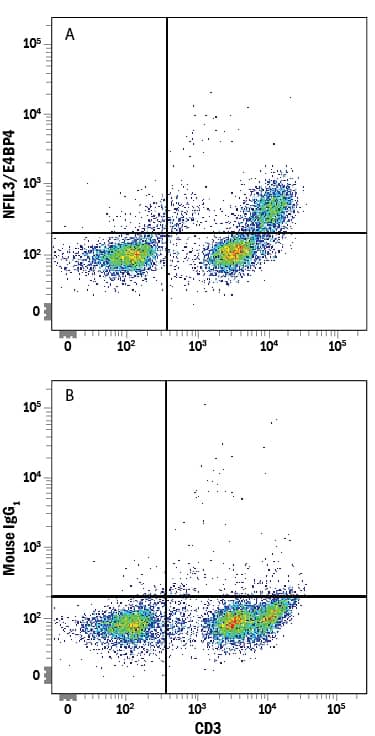Human NFIL3/E4BP4 Antibody
R&D Systems, part of Bio-Techne | Catalog # MAB8570


Conjugate
Catalog #
Key Product Details
Validated by
Biological Validation
Species Reactivity
Human
Applications
CyTOF-ready, Flow Cytometry
Label
Unconjugated
Antibody Source
Monoclonal Mouse IgG1 Clone # 714401
Product Specifications
Immunogen
E. coli-derived recombinant human NFIL3/E4BP4
Lys140-Gly462
Accession # Q16649
Lys140-Gly462
Accession # Q16649
Specificity
Detects human NFIL3/E4BP4 in direct ELISAs.
Clonality
Monoclonal
Host
Mouse
Isotype
IgG1
Scientific Data Images for Human NFIL3/E4BP4 Antibody
Detection of NFIL3/E4BP4 in Human PBMCs by Flow Cytometry.
Human peripheral blood mononuclear cells (PBMCs) treated with PMA and Calcium Ionomycin for 24 hours were stained with Mouse Anti-Human CD3e PE-conjugated Monoclonal Antibody (Catalog # FAB100P) and either (A) Mouse Anti-Human NFIL3/E4BP4 Monoclonal Antibody (Catalog # MAB8570) or (B) Mouse IgG1Isotype Control (Catalog # MAB002) followed by Allophycocyanin-conjugated Anti-Mouse IgG Secondary Antibody (Catalog # F0101B) To facilitate intracellular staining, cells were fixed and permeabilized with FlowX FoxP3 Fixation & Permeabilization Buffer Kit (Catalog # FC012).Applications for Human NFIL3/E4BP4 Antibody
Application
Recommended Usage
CyTOF-ready
Ready to be labeled using established conjugation methods. No BSA or other carrier proteins that could interfere with conjugation.
Flow Cytometry
0.25 µg/mL
Sample: Human peripheral blood mononuclear cells (PBMCs) treated with PMA and Calcium Ionomycin were fixed and permeabilized with FlowX FoxP3 Fixation & Permeabilization Buffer Kit (Catalog # FC012).
Sample: Human peripheral blood mononuclear cells (PBMCs) treated with PMA and Calcium Ionomycin were fixed and permeabilized with FlowX FoxP3 Fixation & Permeabilization Buffer Kit (Catalog # FC012).
Formulation, Preparation, and Storage
Purification
Protein A or G purified from hybridoma culture supernatant
Reconstitution
Reconstitute at 0.5 mg/mL in sterile PBS.
Formulation
Lyophilized from a 0.2 μm filtered solution in PBS with Trehalose.
Shipping
The product is shipped at ambient temperature. Upon receipt, store it immediately at the temperature recommended below.
Stability & Storage
Use a manual defrost freezer and avoid repeated freeze-thaw cycles.
- 12 months from date of receipt, -20 to -70 °C as supplied.
- 1 month, 2 to 8 °C under sterile conditions after reconstitution.
- 6 months, -20 to -70 °C under sterile conditions after reconstitution.
Background: NFIL3/E4BP4
References
- Seillet C, et al (2014) J Exp Med. 211:1733.
- Geiger TL, et al (2014) J Exp Med. 211:1723.
Long Name
Nuclear Factor, Interleukin 3 Regulated
Alternate Names
E4BP4, IL3BP1, NF-IL3A
Gene Symbol
NFIL3
UniProt
Additional NFIL3/E4BP4 Products
Product Documents for Human NFIL3/E4BP4 Antibody
Product Specific Notices for Human NFIL3/E4BP4 Antibody
For research use only
